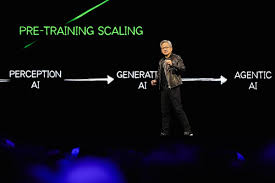Nvidia cNVDAc saw its stock rise over 1% on a Wednesday morning, bouncing back from a two-day decline where shares fell by 5%. The drop occurred during the company's annual GTC event, which failed to excite investors amidst a broader market downturn. Despite this, Wall Street analysts left CEO Jensen Huang's GTC 2025 keynote on Tuesday with renewed optimism regarding Nvidia's roadmap and the demand for AI. They reaffirmed their bullish outlook on the chipmaker, countering concerns about potential decreases in demand due to more efficient AI models.
Analysts like Citi's Atif Malik expressed confidence in Nvidia's leadership, with the company's upcoming AI chip releases generating interest. During the keynote, Huang unveiled the roadmap for Nvidia's future AI chips, including the Blackwell Ultra set for release in the second half of 2025, Vera Rubin in the second half of 2026, and Vera Rubin Ultra in the second half of 2027. He also projected data center spending on compute hardware to reach $1 trillion, showing his optimism for the market's growth.
Raymond James' Srini Pajjuri echoed Citi's sentiment, noting Nvidia's strong position in the AI sector and their technological advancements. Similarly, Bernstein's Stacy Rasgon praised Nvidia's roadmap, emphasizing the company's competitive edge across various product lines. Huang's presentation also allayed concerns that more cost-effective AI models could diminish the demand for AI chips, receiving support from analysts like JPMorgan's Harlan Sur.
Despite the positive reception by many analysts, some, like Jefferies' Blayne Curtis, remained cautious. Curtis highlighted the need for more comparisons between Nvidia's GPUs and competitors' offerings, expressing reservations about the incremental updates planned for 2026. Nonetheless, he acknowledged Nvidia's continued innovation in AI hardware and maintained his Buy rating on the stock.
Following Huang's keynote address, Nvidia's stock experienced a 3.4% decline, contributing to a more than 17% drop over the past month. This downturn coincided with a broader decline in Big Tech stocks, driven by macroeconomic uncertainties due to policies under the Trump administration.
In a move to empower AI developers, researchers, data scientists, and students, Nvidia unveiled the NVIDIA DGX™ personal AI supercomputers powered by the NVIDIA Grace Blackwell platform. Among the new products introduced are the DGX Spark and DGX Station™, both designed to enable users to prototype, fine-tune, and run large AI models on their desktops. These devices offer powerful performance, leveraging the Grace Blackwell architecture previously only available in data centers.
DGX Spark, touted as the world's smallest AI supercomputer, features the NVIDIA GB10 Grace Blackwell Superchip optimized for desktop use. It offers significant computational power for AI reasoning models and benefits from advanced technologies like NVLink™-C2C interconnect to enhance memory access and performance. The Nvidia full-stack AI platform ensures seamless model transfer between desktops, DGX Cloud, and other infrastructure with minimal adjustments.
On the other hand, DGX Station harnesses data-center-level performance to enhance AI development on desktops. Equipped with the NVIDIA GB300 Grace Blackwell Ultra Desktop Superchip, it boasts a considerable memory capacity for large-scale AI workloads. This desktop supercomputer excels in performance and system communication, supported by features like the NVIDIA ConnectX®-8 SuperNIC for optimized networking capabilities.
By providing AI developers with these advanced tools, Nvidia aims to transform the way AI workloads are managed and foster innovation in the industry. Reservations for the DGX Spark systems are open, and DGX Station is set to be available later this year through various manufacturing partners, including ASUS, Dell, HP, and Lenovo.
In conclusion, Nvidia's strategic focus on advancements in AI hardware and its commitment to empowering AI developers through innovative products like the DGX Spark and DGX Station underline the company's position as a leader in the AI computing space. Despite short-term market fluctuations, Nvidia's long-term vision and technological roadmap reflect its dedication to meeting the evolving demands of the AI industry.

